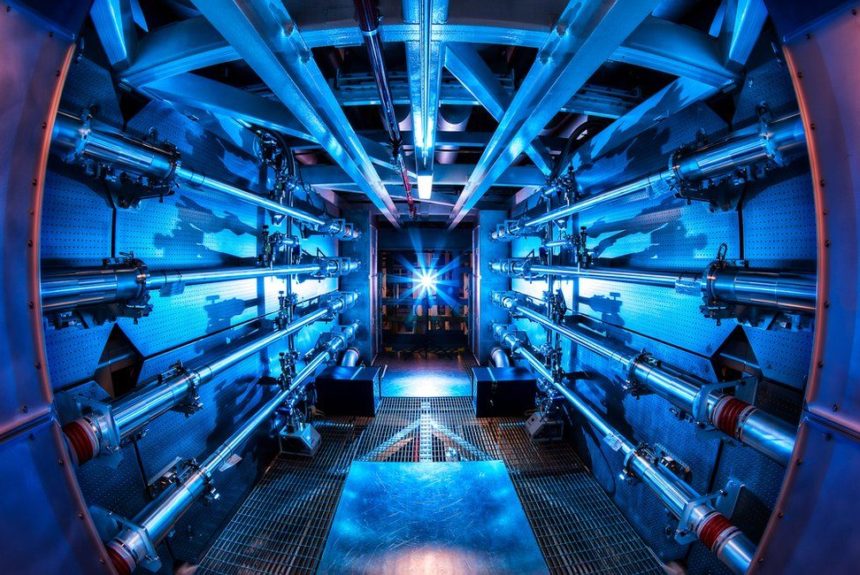In August, the Department of Energy’s National Ignition Facility (NIF) announced a new nuclear fusion breakthrough, leading to countless assertions that humanity was one step closer to the “holy grail of clean energy.” It was an exciting development but also an overhyped one.
A nuclear fusion reaction essentially puts two hydrogen atoms together at temperatures some seven times hotter than the center of the Sun until they fuse into a single helium atom, releasing energy in the process. In December, during a five-second experiment, NIF scientists successfully achieved that nuclear fusion reaction with a net gain of energy. In that brief moment, the amount of energy they created was slightly greater than the amount it took to pressure cook the atoms and generate the fusion reaction. Last month, they replicated the experiment, netting a slightly greater energy yield.
>>>READ: How Fusion Power Can Help Balance the Federal Budget
Those are cool scientific breakthroughs. But as it pertains to today’s clean energy transition, these breakthroughs have little significance to energy consumers.
The world already has abundant carbon-free energy sources that achieve a net gain of energy. Solar. Wind. Nuclear Fission. Hydro. Geothermal. To use solar as an example, the most conservative estimates have solar panels generating four to five times as much energy as it takes to manufacture them. Others suggest that the number could be as high as thirty or more. And just as this nuclear fusion breakthrough puts the technology on an improvement trajectory, solar panel technology is developing too, pushing that number higher every year.
Clean energy sources are becoming increasingly cost-competitive with conventional sources of energy. From 2010 to 2019, unit costs of solar energy decreased by 85%, wind energy by 55%, and lithium-ion batteries by 85%. With these developments, 62% of the renewables that came on stream in 2020 proved less expensive energy than the lowest cost source of new fossil fuel-fired electricity. In fact, it is now cheaper in the United States to build new solar or wind farms and connect them to the grid than it is to simply keep operating 209 out of our 210 existing coal plants.
No single energy source is a silver-bullet “holy grail of clean energy.” But if we’re seeking a suite of technologies that can collectively power a low-carbon electric grid, we may already have them.
Clean energy isn’t a future prospect either. In 2021, renewable energy accounted for 19.8% of electricity consumption in the United States. Nuclear fission contributed another 18.9%. These clean energy sources are here now, and as their share of the electric grid skyrockets, it’s clear they are more than capable of fueling our energy transition without the help of nuclear fusion. We should celebrate the fusion breakthrough for its scientific significance and continue supporting cutting-edge research and development. One day in the distant future, commercial fusion could power the world. But we should also embrace the remarkable strides in the clean energy sector benefiting consumers today.
>>>READ: The Fusion Case for Fission
To be clear, solar and wind enjoy generous subsidies and tax credits which have skewed investment decisions and turbocharged this progress. And apples-to-apples comparisons of electricity cost by sources have proven to be difficult. But even still, consumer choice and market forces are driving this clean energy progress today.
That’s not to say these energy sources don’t have flaws. Nuclear fission produces radioactive byproducts, hydroelectric dams can interrupt salmon migrations, solar and wind only work when the Sun is shining and the wind is blowing, and all these energy sources bring concerns around land use, geopolitics, and human rights. But many of these flaws have room for improvement, especially in a context where they are joining a diversified electric grid and don’t have to be a silver-bullet solution. Ultimately, if each individual energy source is very good, they can join forces on the electric grid to become great — competing with each other on price and quality, but also cooperating by providing backup plans for consumers in the case of, say, bad weather.
On the flip side, nuclear fusion is in its infancy. Many researchers overzealously toss out predictions that “nuclear fusion will be viable in thirty years,” but even with an ambitious timeline like that, nuclear fusion would come too late to be deemed a climate change solution. While a new clean energy source would be welcome to meet future demand, fusion should not be viewed as a way to reach global climate targets, nor should the international community wait on its arrival before pursuing ways to continue reducing emissions. Instead, policymakers and businesses should prioritize the clean energy sources that are already available while awaiting next-generation research and development.
NIF’s nuclear fusion breakthrough is, no doubt, captivating for science enthusiasts. But let’s keep things in their right context: The fact that our current clean energy sources can outcompete fossil fuels (arguably without subsidies) and produce carbon-free electricity with low costs, solid efficiency, and for longer than five seconds — that’s a way more exciting story.
Ethan Brown is a Writer and Commentator for Young Voices with a B.A. in Environmental Analysis & Policy from Boston University. He is the creator and host of The Sweaty Penguin, an award-winning comedy climate program presented by PBS/WNET’s national climate initiative “Peril and Promise.” Follow him on Twitter @ethanbrown5151.
The views and opinions expressed are those of the author’s and do not necessarily reflect the official policy or position of C3.
